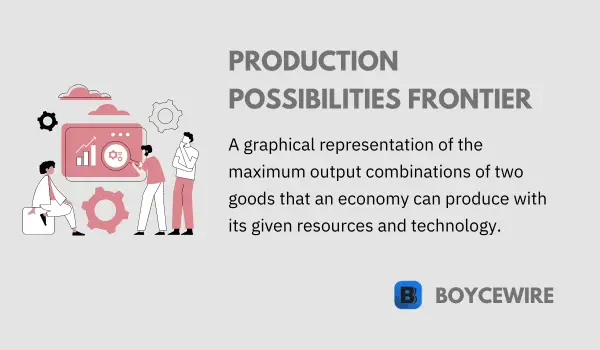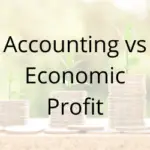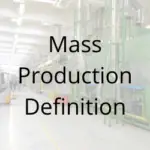Table of Contents ![]()
Production Possibilities Frontier: Definition, Causes & Examples

What is Production Possibilities Frontier?
The Production Possibilities Frontier, or PPF, is a cornerstone concept in economics that visually represents the trade-offs and choices an economy faces in the production of two goods or services. The PPF illustrates the maximum attainable level of output for these goods given a fixed amount of resources, and the technological constraints.
A key assumption of the PPF model is that the economy is operating at a fully efficient level—meaning resources are fully employed and utilized optimally. Additionally, it assumes that the state of technology is constant during the period of analysis. The concept of the PPF underscores two fundamental economic principles: scarcity and choice. Since resources are limited (scarcity), economies must make decisions about how to allocate them most efficiently (choice). These choices invariably involve trade-offs—increasing the production of one good means decreasing the production of another. The PPF offers a simple yet powerful tool to visualize these economic trade-offs and opportunity costs, and it provides critical insights into the implications of resource allocation decisions. In the following sections, we will delve deeper into understanding the PPF, its implications for economic theory and practice, and its relevance in the real world.Key Points
- The Production Possibilities Frontier (PPF) is a graphical representation of the different combinations of two goods that an economy can produce with its given resources and technology.
- The PPF illustrates the concept of trade-offs and opportunity costs, as producing more of one good requires sacrificing the production of another good.
- Points on the PPF represent efficient utilization of resources, while points inside the curve represent inefficient production and points outside the curve are currently unattainable.
Understanding the Production Possibilities Frontier (PPF)
The Production Possibilities Frontier is a graphical representation that shows the combinations of two commodities that can be produced using the same factors of production and the same level of technology, assuming full efficiency and full employment. The commodities can be any pair of goods, services, or outputs an economy can produce.
Each point on the PPF represents one set of choices an economy can make, essentially the combinations of the two goods that can be produced using all available resources efficiently. Any point inside the PPF indicates underutilization or inefficiency—meaning that the economy could produce more of at least one good without sacrificing the production of the other. A point outside the PPF is currently unattainable, given the current resources and technology.
Two central concepts associated with the PPF are efficiency and opportunity cost:
- Efficiency: There are two types of efficiency tied to the PPF—productive efficiency and allocative efficiency. Productive efficiency refers to the concept that an economy cannot produce more of one good without producing less of another. This occurs when the economy is producing at any point on the PPF. Allocative efficiency, on the other hand, occurs when the mix of goods produced represents the mix that society most desires. This is achieved when the economy operates on the point of the PPF that aligns with societal preferences.
- Opportunity Cost and Trade-offs: The PPF also illustrates the concept of opportunity cost, which is the cost of forgoing the next best alternative when making a decision. In the context of the PPF, the opportunity cost of producing more of one good is the amount of the other good that must be given up. This demonstrates the idea of trade-offs—the fact that, due to scarcity, producing more of one good or service means producing less of another.
By understanding the PPF and the principles it illustrates, we can gain valuable insights into the decision-making process that economies undertake in dealing with scarce resources and unlimited wants.
Shifts in the Production Possibilities Frontier (PPF)
While a Production Possibilities Frontier (PPF) illustrates the feasible combinations of two goods or services that an economy can produce at a given time, it’s essential to understand that the PPF isn’t static. It can shift due to changes in the underlying factors. A shift in the PPF can be outward or inward, indicating an expansion or contraction of an economy’s production capacity, respectively.
Causes of PPF Shifts:
- Changes in Resource Quantity or Quality
- Technological Progress
- Improvements in Rules and Institutions
- Destruction of Resources
- Societal Choices
1. Changes in Resource Quantity or Quality:
An increase in the quantity or quality of resources, such as labor, capital, or natural resources, will cause an outward shift of the PPF. For example, population growth can expand the labor force, leading to increased production capacity. Similarly, improvement in the quality of resources, such as through better education or training, leading to a more skilled workforce, can also expand production possibilities.
2. Technological Progress:
Technological advancements can allow an economy to produce more output with the same amount of resources, leading to an outward shift of the PPF. For instance, advancements in machinery can enhance productivity in manufacturing, increasing the potential output of goods.
3. Improvements in Rules and Institutions:
Better laws, regulations, or institutions can improve the efficiency of production, causing the PPF to shift outward. This includes things like property rights, political stability, or any changes that improve the functioning of the economy.
4. Destruction of Resources:
Events that diminish resources, such as natural disasters, wars, or significant economic downturns, can cause the PPF to shift inward, indicating a reduction in an economy’s production capacity.
5. Societal Choices:
If a society chooses to increase investment in capital goods over consumer goods, it can lead to economic growth in the future (outward shift in PPF), as increased capital goods can enhance future production.
Shape of the Production Possibilities Frontier (PPF)
The shape of the Production Possibilities Frontier (PPF) reflects the law of increasing opportunity costs, a fundamental principle in economics. This law holds that as an economy reallocates resources to produce more of one good, the opportunity cost of producing that good increases.
Typically, a PPF is bowed outwards from the origin (concave) and this specific shape is not arbitrary but represents an important feature of economic production: resources are not perfectly adaptable for all uses.
Consider an economy that produces two goods: computers and wheat. Some resources are better suited to producing computers, while others are better for wheat production. As the economy begins to produce more computers, it initially shifts the resources most suited to computer production away from wheat. The opportunity cost in terms of wheat given up to get more computers is relatively low.
However, as the production of computers continues to increase, the economy must shift resources better suited for wheat production. The additional computers are more costly in terms of the amount of wheat given up. Hence, the opportunity cost of computer production rises—the law of increasing opportunity costs. This increasing cost results in a concave, or bowed-out, shape of the PPF.
If opportunity costs are constant, the PPF would be a straight line. This scenario implies that resources are perfectly adaptable for producing either good, which is a strong and often unrealistic assumption.
The shape of the PPF, therefore, tells us about the trade-offs an economy faces and the adaptability of its resources. Understanding these concepts is crucial for making informed decisions about how to best use an economy’s scarce resources.
Examples of Production Possibilities Frontier (PPF)
To illustrate the concepts of the Production Possibilities Frontier (PPF), let’s explore some examples:
Example 1: A Simple Economy Producing Apples and Oranges
Imagine a small economy that produces only two goods: apples and oranges. Suppose this economy has a fixed quantity of resources, and technology remains constant. Let’s say that if all resources go into apple production, the economy can produce 600 apples and no oranges. If all resources go into orange production, it can produce 300 oranges and no apples. The PPF for this economy might look like a downward-sloping line (or curve) with apples on one axis and oranges on the other.
Any point on the line represents a combination of apples and oranges that the economy can produce efficiently. Points inside the line indicate inefficiency, and points outside are currently unattainable given the existing resources and technology.
Example 2: An Economy Producing Consumer Goods and Capital Goods
Consider an economy that can produce only consumer goods (like food and clothing) and capital goods (like machines and buildings). Assume that at one extreme, it can dedicate all resources to consumer goods, producing 1000 units and no capital goods. At the other extreme, it could produce 500 units of capital goods and no consumer goods.
The PPF would again be a downward-sloping line or curve, with consumer goods on one axis and capital goods on the other. An outward shift of this PPF could represent economic growth—maybe due to a technological advance or an increase in resources—allowing the economy to produce more of both goods.
Example 3: Country A Producing Cars and Airplanes
Imagine Country A has enough resources to manufacture either 500 cars or 200 airplanes, or a combination of both. The PPF would show the possible combinations of cars and airplanes that the country can produce.
If Country A decides to produce only cars, it will manufacture 500 cars and no airplanes. If it only manufactures airplanes, it will produce 200 airplanes and no cars. But it can also opt for any combination in-between depending on its needs and international trade strategy. A point within the PPF indicates that the country is not fully utilizing its resources or is not efficient in its production, while a point outside the PPF represents a currently unachievable production level given the existing resources and technology.
Example 4: Country B Producing Wheat and Corn
Now, consider Country B, an agrarian economy that can produce two goods: wheat and corn. The country has 1,000 acres of farmland it can use to grow either wheat or corn or some combination of the two.
If the country decides to devote all of its resources to wheat production, it can produce 3,000 bushels of wheat and zero bushels of corn. On the other hand, if it devotes all of its resources to corn, it can produce 2,000 bushels of corn and zero bushels of wheat. Various combinations of wheat and corn production are possible if the country divides its resources between the two crops. The PPF will show these possible combinations.
Importance of the Production Possibilities Frontier (PPF)
The Production Possibilities Frontier (PPF) is a crucial concept in economics for several reasons:
- Understanding Trade-offs and Opportunity Cost: The PPF vividly demonstrates the fundamental economic problem of scarcity. Given limited resources, producing more of one good inevitably means producing less of another. This trade-off illustrates the concept of opportunity cost, or the cost of forgoing the next best alternative when making a decision. The PPF makes these abstract concepts more tangible and easier to understand.
- Illustrating Efficiency: Any point on the PPF represents productive efficiency: the economy is maximizing the production of goods given its resources. Points inside the PPF represent inefficiency, while points outside are currently unattainable. This helps economists and policymakers understand whether an economy is fully utilizing its resources and helps identify areas for potential improvement.
- Understanding the Effects of Economic Growth and Decline: The PPF can shift due to changes in resources, technology, and efficiency. An outward shift of the PPF represents economic growth, while an inward shift suggests economic decline. This feature of the PPF allows us to visualize the impact of these changes on an economy’s capacity to produce goods and services.
- Allocative Efficiency and Decision-Making: The PPF also helps us understand the concept of allocative efficiency, which occurs when the mix of goods produced represents the mix that society most desires. By helping visualize the trade-offs and benefits of different production combinations, the PPF assists in making informed decisions about the allocation of resources.
- Understanding Specialization and Comparative Advantage: The PPF provides a framework to understand the benefits of specialization and comparative advantage in trade. Countries will often specialize in producing goods where they have a comparative advantage (i.e., they can produce the good at a lower opportunity cost), leading to greater overall efficiency and gains from trade.
In summary, the PPF is a fundamental tool in economic analysis. It provides insights into the principles of opportunity cost and efficiency, illustrates the impact of economic growth or decline, and aids in decision-making regarding resource allocation. Understanding the PPF, therefore, is essential for both economists and policymakers.
FAQs
The PPF is a graphical representation of the maximum output combinations of two goods that an economy can produce given its resources and technology.
The PPF illustrates the concept of trade-offs and opportunity costs, showing the different production possibilities and the sacrifices that need to be made when allocating resources to produce more of one good at the expense of another.
Points on the PPF represent efficient utilization of resources, where the economy is producing goods at the maximum possible output given its resources and technology.
Points inside the PPF represent inefficient production, where resources are not fully utilized, while points outside the PPF are currently unattainable with the given resources and technology.
About Paul
Paul Boyce is an economics editor with over 10 years experience in the industry. Currently working as a consultant within the financial services sector, Paul is the CEO and chief editor of BoyceWire. He has written publications for FEE, the Mises Institute, and many others.

Further Reading
 Accounting vs Economic Profit - The main difference between accounting and economic profit is that economic profit includes implicit costs. Whilst accounting profits include the…
Accounting vs Economic Profit - The main difference between accounting and economic profit is that economic profit includes implicit costs. Whilst accounting profits include the…  Mass Production: Definition, Examples, Pros & Cons - Mass production is the continuous production of standardized products, usually along an assembly line.
Mass Production: Definition, Examples, Pros & Cons - Mass production is the continuous production of standardized products, usually along an assembly line.  Fractional Reserve Banking - Fractional reserve banking is a system in which banks are only required to hold a fraction of customer deposits as…
Fractional Reserve Banking - Fractional reserve banking is a system in which banks are only required to hold a fraction of customer deposits as… 